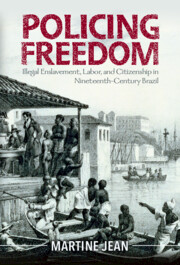Book contents
- Policing Freedom
- Afro-Latin America
- Policing Freedom
- Copyright page
- Dedication
- Contents
- Figures
- Maps
- Tables
- Acknowledgments
- Introduction
- 1 The Politics of Slavery, Race, Nation, and Prison Building
- 2 Confinement, Labor, and Citizenship
- 3 Prison Labor and the Politics of Slavery
- 4 Disciplining Children and Engendering Racialized Citizenship
- 5 Adelino Mwissicongo and the Afterlife of Emancipation
- Conclusion: Slavery’s Punitive Afterlife
- Appendices
- Bibliography
- Index
2 - Confinement, Labor, and Citizenship
Published online by Cambridge University Press: 03 August 2023
- Policing Freedom
- Afro-Latin America
- Policing Freedom
- Copyright page
- Dedication
- Contents
- Figures
- Maps
- Tables
- Acknowledgments
- Introduction
- 1 The Politics of Slavery, Race, Nation, and Prison Building
- 2 Confinement, Labor, and Citizenship
- 3 Prison Labor and the Politics of Slavery
- 4 Disciplining Children and Engendering Racialized Citizenship
- 5 Adelino Mwissicongo and the Afterlife of Emancipation
- Conclusion: Slavery’s Punitive Afterlife
- Appendices
- Bibliography
- Index
Summary
This chapter probes the mobilization of liberated Africans, convicts, slaves, and vagrants to build the Casa de Correção between 1834 and 1850. Drawing from research on how modernizing political elites developed administrative, technical, and identification technologies to render peripatetic peoples legible for the purpose of taxation and labor control, the chapter investigates how the construction of the Casa de Correção evolved into a project of legibility to regulate the effects of the campaign against human trafficking. Through its punitive and labor discipline roles, the penitentiary evolved into an important site of racialization of the poor along cleavages that assigned differentiated treatment by legal status – slave or free – and ethnic origins – European immigrants, Brazilians, or Africans. The penitentiary reinforced existing divisions in Brazilian society between slaves and free, foreigners and nationals, while blurring the lines of distinctions among these categories through the regime of labor and confinement.
Keywords
- Type
- Chapter
- Information
- Policing FreedomIllegal Enslavement, Labor, and Citizenship in Nineteenth-Century Brazil, pp. 106 - 152Publisher: Cambridge University PressPrint publication year: 2023



